Who is the main engine of the software development process? You might say that business. Because precisely the business purpose makes managers turn bold ideas into reality. Or probably engineers since they are the brains and hands running the entire development cycle. I would say both options are correct. But there is another one named project managers (PMs). At first glance, they play a secondary role. Meanwhile, exactly PMs are a middle link between business leaders and tech teams, helping both parties to reach common ground regarding development and its results.
Following the latest CHAOS report, only 31% of projects are successful. The rest, 69%, are challenging or failed. The core reasons for this unsatisfactory trend are the absence of proper management and the lack of efficient communication between businesses and techies. So, project managers are the specialists capable of making a global shift in this field and ensuring high ROI for most started IT projects.
This FAQ-like article aims to show you the core tasks and challenges project managers usually deal with to explain why their participation is crucial for an any-scaled development project. Scroll down to dive into details!
Project Managers and Their Areas of Responsibility: General Overview
What is a project?
Oxford Dictionary defines “project” as a “planned piece of work that is designed to find information about something, to produce something new, or to improve something” or “a set of aims, ideas or activities that somebody is interested in or wants to bring to people’s attention.”
Let’s turn both options into something average. Consequently, a project is a step-by-step transformation of a set of ideas that somebody is interested in into the ultimate expected results through the planned and performed piece of work.
What is an IT project?
Based on the definition we’ve just received, let’s conclude that an IT project is a scope of business-driven ideas that should be implemented into real software products following strict and detailed requirements through the well-organized, step-by-step software development process.
Here we have:
- the certain parties: business leaders (as a client) and tech team (as a vendor)
- the precise way to achieve results (i.e., the software development cycle)
- the result (software product, such as program, app, etc.)
Who is responsible for the IT project?
To some extent, all specialists involved in development are responsible for the IT project or even for the part of the IT project they perform and the results they can deliver. Meanwhile, the responsibility for the entire project lies on the project manager’s shoulders.
Who is a Project Manager?
“Project Manager is a specialist whose main task is to manage the project as a whole: design and prioritization, task scheduling, control, communication, and prompt problem solving. We used to make ‘Project Manager’ a synonym of ‘IT Project Manager’, but it’s not true. Each project or activity requires a Project Manager – a person, who can organize and run it from the idea to the measurable results.”
Zoya Boyko,
Project Manager, IDAP
So who is this superman capable of handling the project and keeping an eye on everything around? The project Manager is a specialist who runs software development project planning, organization, and execution. In other words, this person creates and manages the entire behavioral architecture within the project. These people usually are pros in management since they should simultaneously perform integration, scope, time, cost, quality, and risk management. So, organizational skills are crucial in this position.
What are the duties & responsibilities of a Project Manager?
Meanwhile, for most people, the Project Manager position is still much easier than the developer’s role. Both are challenging, and sometimes the Project Manager tries even harder to achieve results. PMs should continuously improve their skills in various domains, from tech to finance, to see the bigger picture and share this vision with the rest of the team. It leads to a significant scope of duties, among which are:
- Management of the team
- Planning and development of a project idea
- Keeping the project progress on the radar
- Creating project documentation
- Communicating with stakeholders
- Problem-solving
- Project estimation and fulfillment of a budget
- Evaluation of employee and project performance
Involve highly experienced Project Managers and engineers in your app development project. Contact the IDAP team to start.
What role do Project Managers play in software development, and when is it impossible to make a decision without them?
As you might notice, Project Managers are core drivers of the entire development process. They know everything about a particular project they lead. They can match developer capabilities and business opportunities to create conditions that will satisfy everybody involved. This way, there are no project-related decisions that could be made without Project management since we’re talking about the only person to say if the scope will be done in time considering the budget measures fulfillment.
What’s the difference in duties of a PM working with outsourcing vs. a product company?
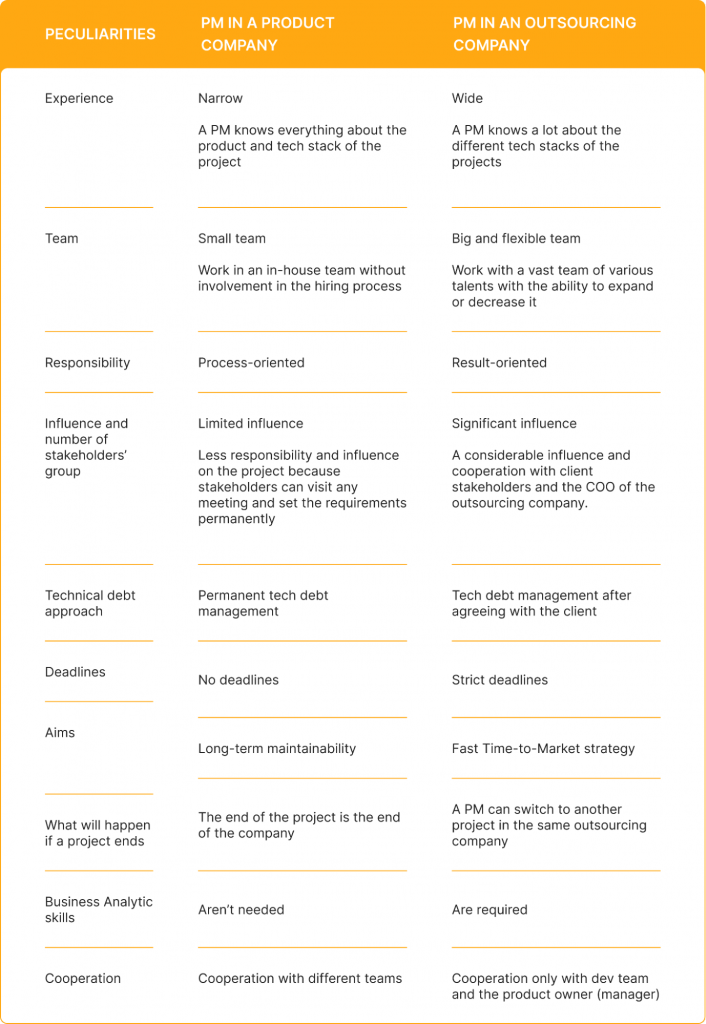
Related:
- Role of Project Manager in App Development Process
- Software Development Project Manager: Role in Dedicated Teams
- In-House or Outsourcing – Which is More Effective for Small and Large Businesses?
- The 10 Best Examples of Outsourcing
- IT Outsourcing in Poland vs Ukraine – Ins and Outs
Project Manager and Software Development Projects
What are the core stages of the software development life cycle?
The entire software development life cycle is divided into several stages, which makes it easier to notice the progress and evaluate results. Consequently, it includes seven main steps: discovery, UX/UI design, development, testing, deployment, and maintenance.
The operation principles are the same for each company, no matter its outsourcing or product. Meanwhile, the set of actions and procedures performed during these stages are different in both cases and depends on:
- the chosen business model
- internal policies & guidelines
- the expertise of specialists involved
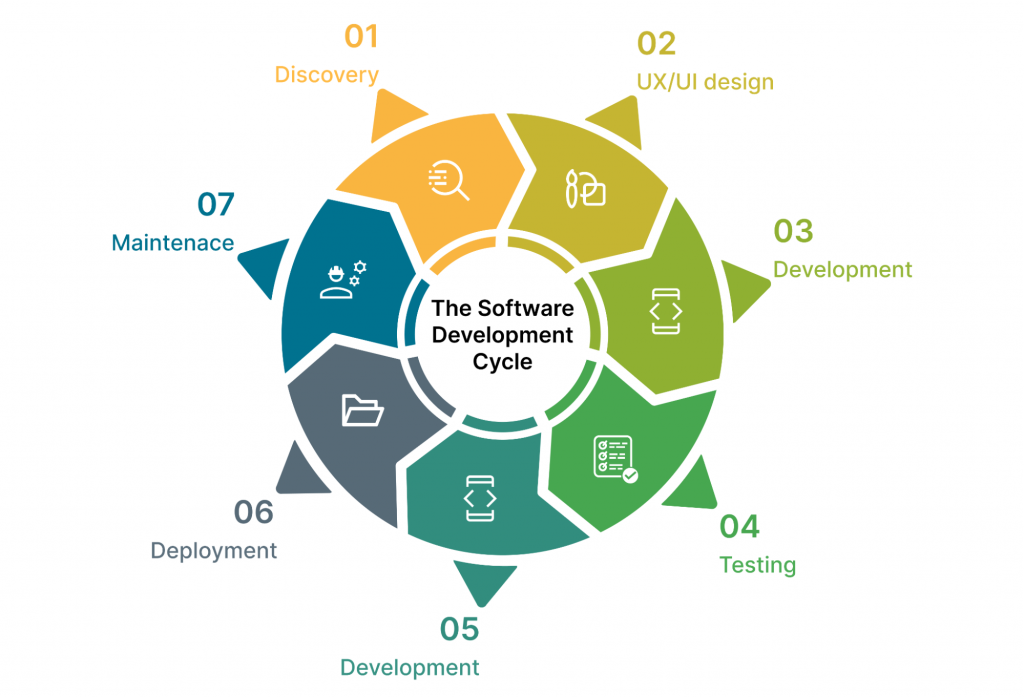
What are the stages of work on a software development project in an outsourcing company?
It seems that a development project in a product company is less curious and engaging for Project Managers that work on SDLC in an outsourcing company. That’s true since the specialist has many more duties and responsibilities in the second case. Nothing can better illustrate the scope of PM’s activities than the transformed development cycle usually applicable to outsourcing companies. Curious that some project management methods make part of this circle repeatedly, applying it to each rolled-out feature.
Eight stages of software development life cycle

What documentation does the PM prepare to ensure a proper development cycle?
In addition to attentive management and performance of an enormous scope of tasks, Project Managers should create several crucial documents that help stakeholders cover all “whats,” “whys,” and “hows” they have regarding the project. Among such copies are:
Work breakdown structure
It is a document illustrating the division of the entire development process into several stages depending on the project’s complexity.
Backlog
Or the entire scope of tasks arising from the work breakdown structure.
Roadmap
The document shows a step-by-step movement toward the goal. Its creation requires cooperation between the Project Manager and a client, who should define the order of tasks in the backlog.
Releases
Based on backlog and roadmap, a Project Manager needs to create releases – the scope of tasks that should be done in a certain period.
Communication plan
The copy defines the communication way, preferable channels, the frequency of requests, and other peculiarities that describe the communication process between a client and an outsourcing team.
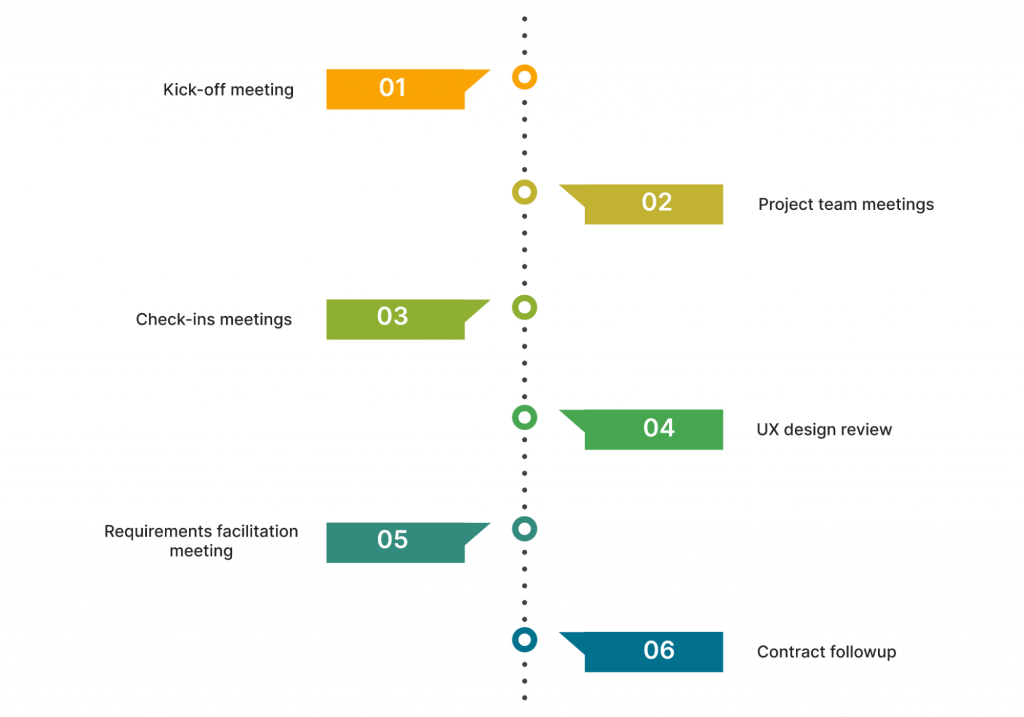
DevOps document
One more management-oriented document describing the cooperation on the DevOps level.
Business case
The copy where a client and a Project Manager define the business purpose for each product feature and the product as a whole. It helps to remain straight to the point during the development and understand the business goal each development component will help achieve.
Scope, Time, Budget: how to manage them?
“Scope, time and budget is a classical triangle of project management. How to remember it easily? Your mum asks you to buy milk (scope). She gives you 3 dollars (budget). And you have to do it by 3 PM today (time). So you will successfully accomplish the project if you buy milk (not cola), bring it at 3 PM or earlier and give the rest to your mum (if any). You see that there are no requirements regarding the brand, shop, what milk (cow or goat, fresh or pasteurized, etc.), how many liters.”
Dmytro Drozd,
PMO Head, IDAP
Have you ever heard about the triple constraint? It’s about the mutual dependency of scope, time, and budget and its effect on software development. Following that rule, if one of the elements (time, scope, or budget) changes, the rest must also change predictably.
Just imagine an equilateral triangle to visualize. It is perfect, right? All angles and sides are equal. This is how time, scope, and budget should be related to each other. But add more investment, and you’ll have to increase the time and broaden the scope of work. Otherwise, you will face over budget without a relevant business purpose. And vice versa, take a part of the investment back, and you will see that it’s crucial to reduce the scope of work and time for the development cycle, or the project will be underestimated. Usually, it leads to poor software product quality, a limited scope of features, etc.
The same rule applies to time and scope, respectively. No matter what development project you’re going to start, small or large, – these three elements should be equal. The Project Manager’s task is to keep an eye on this synergy and make it work properly.

Looking for a way to find a middle ground between time, scope and budget of your app development? Contact us to explore how to manage it in your business conditions.
Related:
- SDLC: Software Development Project Phases [Guide for Clients]
- Discovery Phase in Software Development: Importance, Stages, Tips
- SDLC Design Phase: Definition, Activities, Goals [2022]
- Guide to Software Testing Outsourcing for Businesses
- Software Testing: 5 Reasons to Get the Best Benefits for Your Business
- 6 Ways to Get the Most Out of Your IT Budget
- How Much Does It Cost to Develop a Custom Application?
What Sort of Management do Project Managers Perform?
How PMs Cope with Quality management?
The project Manager is responsible for product quality – the total number of features that meet expectations and satisfy the stated needs. All product features must work as expected for a given time. To fulfill the duty regarding proper quality management, PMs usually cover two processes: quality planning and quality control.
Quality planning defines product quality criteria, methods used to check quality, acceptance criteria, and responsibilities. Usually, Project Managers implement quality planning in the Business Case copy mentioned above.

Meanwhile, quality control focuses on the techniques and activities to inspect & test products. It would also include looking for ways to improve quality and remove less-satisfactory performance constantly.

Are Project Managers involved in Risk management?
Another task for the Project Manager is the need to manage risks during the entire project. Too many pitfalls are ready to destroy a software development project, so PMs should identify, evaluate and prevent them from ensuring high-quality, expected, and timely results.
“It is the art of how to behave in the future planned today. The PM has to predict what issues could intervene the success, what problems he will have to solve, what are the possible tolerances and what behavior will suit best in a case.”
Dmytro Drozd,
PMO Head, IDAP
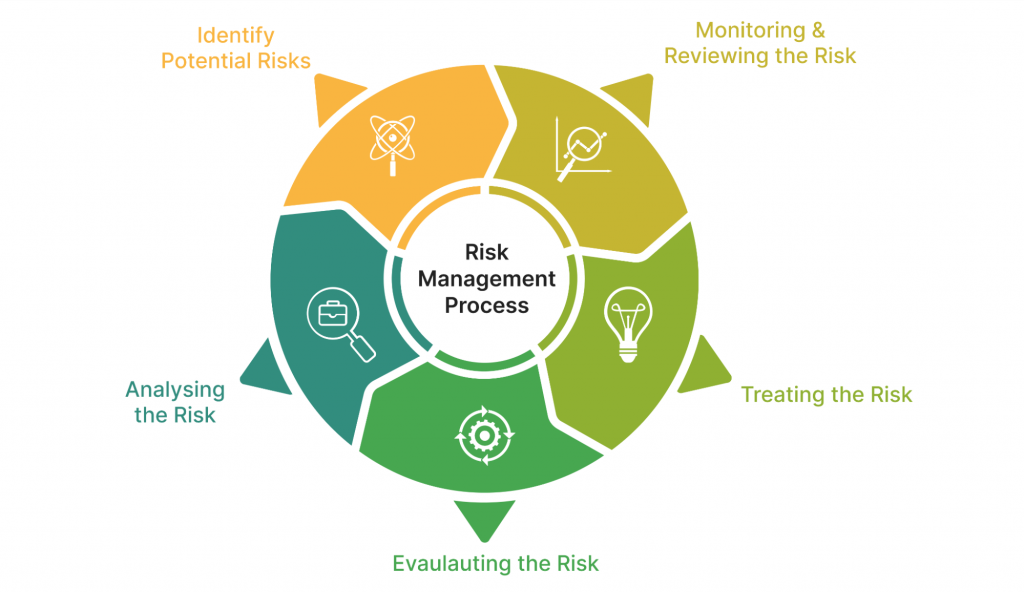
What is Client-oriented project management?
Each software development process makes sense only if it’s based on a relevant business purpose and aims to cover it. You might say that it’s not a priority for product companies. Meanwhile, B2B vendors should know their clients and tailor the software produced to user behavior, dynamic market conditions, demand, etc. So, project management should be client-oriented in any case because the client comes first anywhere.
This approach is more visible regarding outsourcing software development companies and their cooperation with customers. There, suppliers are responsible for creating custom software, so attention to client requirements and details is crucial to success. In this case, another task for the Project Manager is to ensure that the development process, cost, time, and other components will consequently play in the customer’s favor.
The client-oriented approach might affect everything, starting with the chosen management method and ending with the messenger suitable for the customer. So, PMs here should cope with two core challenges: satisfy a client and help the team feel convenient under any conditions offered or created by the customer.
Related:
- Guide to Customer Relationship Management Process
- Communication Strategy for Project Management: How PMs should work with clients
How Project Managers Optimize Development Process
Which is better, Agile or Waterfall?
Project Managers use various methods of organizing projects depending on:
- a company they are working in (outsourcing or product)
- team behavior and professional habits
- client requirements when it comes to outsourced software development
Here we’ll briefly consider two methodologies to explore what project they suit best. First of all, both Agile and Waterfall are efficient approaches but in relevant conditions.
Agile is a project management method that divides the entire development cycle into several mini-project (releases) to provide a step-by-step delivery and build a further operation based on results. This approach is pretty flexible since the functionality of the ultimate solution might change quickly depending on the client’s expectations. The Agile-based development process looks like a funnel where the completion of each release reduces the backlog (the entire scope of tasks) at times. Agile requires close cooperation with stakeholders and constant idea/product improvement during the development project.
This method is suitable for teams that strive to speed up time-to-market and exceed expectations regarding the ultimate results.
Meanwhile, the Waterfall method makes the team follow a step-by-step linear process by working on each project stage in order: from planning to maintenance. This approach is less flexible and suitable for dynamic demand. Since Project Managers anyway prefer it when:
- a team has strict and clear requirements from clients
- developers are already familiar with the used tech stack
“Somebody tells that Waterfall is ancient and doesn’t work. Completely wrong. Try to build the Aerospace shuttle using Agile and I will never come to the launch. It could be really dangerous. On the other hand, developing the SAAS product using Waterfall is a little bit strange. Because you have lots of ways to do the same, the client’s problem can change, the priorities as well, the competitors can introduce smth essential for you to change the flow etc. So it’s always up to you to choose the appropriate approach to achieve the goal.”
Dmytro Drozd,
PMO Head, IDAP
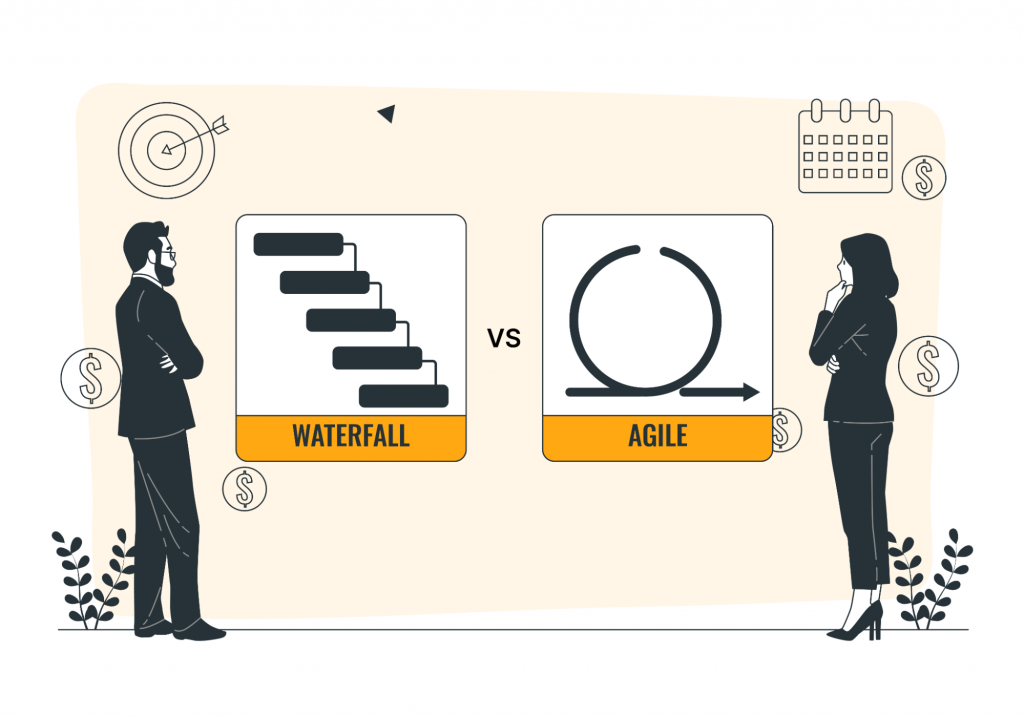
If you want to speed up Time-to-Market and optimize an app development cycle using a real Agile approach – contact the IDAP sales team to opt for the most appropriate starting point.
What tools can Project Managers use to succeed?
Regardless of the management method chosen by Project Managers, they anyway need additional software tools to allow them to:
- create and process development ideas
- drive the entire development process
- control the performance of engineers
- create project documentation, etc.
They must ensure that the process is well-designed, clear, and transparent for every specialist involved. It’s impossible to do just with a spreadsheet. So, several advanced instruments came to the rescue. Among the software products Project Managers use are Jira, Google Docs, Confluence, and Figma.
How does Jira automation help PMs run the development process?
The must-have for every Project Manager is to have a Jira at hand. This tool is a versatile environment designed by Atlassian, particularly for simplifying the project management process. The product has a unique user-friendly workflow for this purpose. With Jira, PMs can:
- track the stage of tasks performance,
- use the reporting feature to evaluate the entire team’s productivity
- optimize engineers’ activities during the development cycle
- define bottlenecks in the development process and eliminate them
- reduce the manual work by applying the Jira automation feature
- control the access to data, saving the proper segregation of duties
Atlassian regularly updates Jira by adding more features that make management convenient and straightforward. Moreover, the company also offers:
- Kanban boards can make the development process transparent, limit work-in-progress and uplift efficiency.
- Confluence is the wiki system used to create an extensive knowledge base.
All the environments are seamlessly integrated, which makes their usage even more convenient. Jira and other tools launched by Atlassian help Project Managers kill two birds with one stone:
- ensure lightning-fast and proper development process
- make the development cycle transparent to supercharge developers’ experience
Related:
- Agile Development Software and Its Main Benefits for Everyone
- Scrum as a part of Agile software development methodology
- Are Agile and DevOps Friends or Foes?
- Top 15 BEST Task Management Software Tools
Meetings drive proper project management
What is a kick-off meeting, and why does it matter?
What is the starting point of each development cycle, i.e., after all contracts are signed, and all conditions are agreed? The entire team and sometimes client-side representatives (when it comes to outsourcing software development) meet on kick-off meeting to:

Project Managers need kick-off meetings to communicate with all stakeholders, collect opinions and understand how to approach the project to make it successful.
Why does a Project Manager hold daily meetings?
As seen, at least software tools and project management methods help PMs cope with the high level of responsibility and continuous flow of tasks. Meanwhile, it’s not enough to save the “teamwork spirit” and understand the development process from the inside. To cover it, Project Managers organize meetings or standups with developers, designers, and other involved specialists daily. Usually, it’s a quick sync-up where team members describe their current tasks, discuss the following steps, and try to define blockers (if so) to eliminate them. This approach is usual for most project management methods since it helps keep coordination between specialists and see the bigger picture of development by summing up all collected information.
What are the retrospective meetings, and why are they needed?
“Retrospective is not so pleasant activity for Project Managers since they should be ready for the feedback. Sometimes it’s too difficult to face mistakes. But it’s crucial to move forward more efficiently.”
Zoya Boyko,
Project Manager, IDAP
Each project ends with the retrospective – a meeting where the team discusses the entire development process. It creates room for improvement in the cooperation between specialists since all of them share their experiences, thoughts, expectations, and results. Retrospective helps Project Managers to discover what supported engineers during the development cycle, what bothered them, and how to reduce the number of weaknesses in the process. Consequently, PMs create action plans to correct mistakes.
Related: Effective Retrospective meeting: Theory & Practice
Project Manager Role: All That Is Hidden
What are the “dos” and “don’ts” of the Project Manager job?
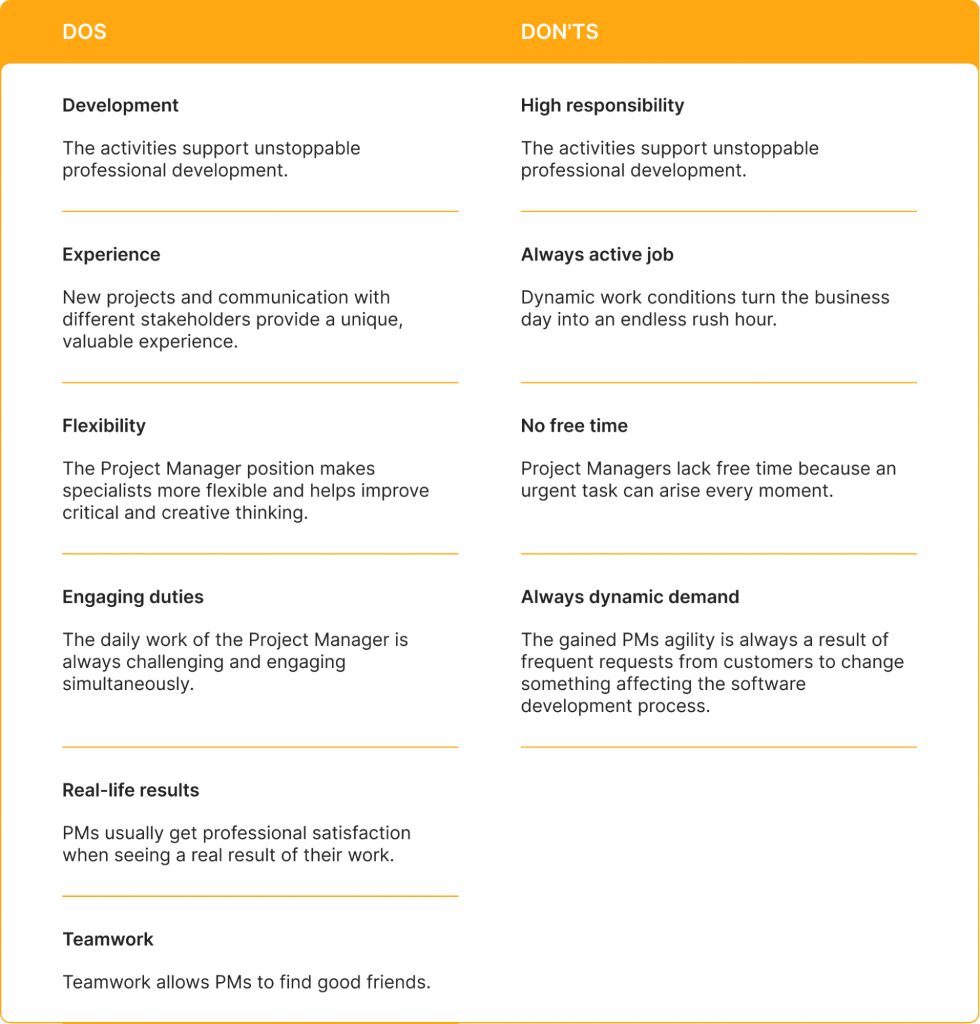
What education do PMs need?
Considering the scope and variety of tasks performed by Project Managers, these specialists probably should be pros in different fields, from IT to psychology. That’s true, but most of the skills needed to perform the PM’s duties properly result from experience. Meanwhile, to dive into the tech part of this job, future Project Managers attend at least one course in the following categories:
- IT development
- UX/UI
- QA
- project management
Do PMs need any certificates?
We’re living in a world where Project Managers can’t prove they are Project Managers only with certificates. Of course, the last ones will be considered a plus. However, years of gained experience will speak much louder. Therefore it’s just enough to show the level of skills in practice.
Do PMs need a tech background?
Most Project Managers have no expertise in the tech field. They just need to understand business logic and translate it to the user stories with the Business Analysts. Meanwhile, sometimes the tech background is compulsory. Otherwise, the PM won’t understand anything. It’s applicable when, for example, a Project Manager should write the API for external users.
How to become a good PM?
The main secret lies in the character’s peculiarities and the desire to grow. A good Project Manager always prefers an active lifestyle, communication with different people, and organization in everything from daily tasks to global projects.
To become a skilled Project Manager, you can start with simple tasks, such as diving into the software development life cycle, trying to write user stories, making simple HTML requests, etc. Then, the synergy of will, knowledge, and engagement will allow you to get relevant experience – the main thing needed to be a first-class Project Manager.
Related: Whether Tech Background is Required for a Project Manager?
Summary
The software development project’s success highly depends on the Project Manager handling all the organizational and communication processes during the cycle. The various tasks and duties make Project Managers pros in different fields and core problem-solvers, helping create software that exceeds customer expectations. If you’re looking for a way to involve such a professional in software development, reach us out. The IDAP team will show you the most appropriate starting point of your development journey and stay with you throughout the entire process.



